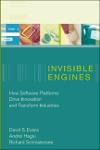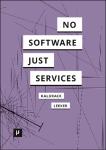Search
Author
- Jorgensen, Ed (3)
- McFadyen, Ron (3)
- Nora, El-Rashidy (3)
- Christian, Homeyer (2)
- next >
Subject
- programming (10)
- Open Access (8)
- Java (7)
- Programming (7)
- next >
Date issued
- 2020 - 2025 (293)
- 2010 - 2019 (39)
- 2000 - 2009 (2)
- 1999 - 1999 (1)
Has File(s)
- true (335)
Search Results
There are a number of excellent, comprehensive, and in-depth texts on MIPS assembly language programming. This is not one of them.The purpose of this text is to provide a simple and free reference for university level programming and architecture units that include a brief section covering MIPS assembly language programming. The text assumes usage of the QtSpim simulator. An appendix is included that covers the download, installation, and basic use of the QtSpim simulator.The scope of this text addresses basic MIPS assembly language programming including instruction set usage, stacks, procedure/function calls, QtSpim simulator system services, multiple dimension arrays, and basic recursion. |
This book is Part I of a two-part set that introduces the Java programming language. The text assumes the student will be using the BlueJ development environment and provides some introductory BlueJ material. Our experience has been that BlueJ is easy to learn and provides a good programming environment for the beginner programmer. |
"Welcome to the Eighth Edition of Introduction to Programming Using Java, a free, on-line textbook on introductory programming, which uses Java as the language of instruction. This book is directed mainly towards beginning programmers, although it might also be useful for experienced programmers who want to learn something about Java. It is not meant to provide complete coverage of the Java language.
The eighth edition requires Java 8 or later, and it uses JavaFX for GUI programming. Version 8.1 is a small update of Version 8.0. This version briefly covers some of the new features in Java 11 and makes it clearer how to use this book with Java 11 and later." |
Harnessing the power of software platforms: what executives and entrepreneurs must know about how to use this technology to transform industries and how to develop the strategies that will create value and drive profits.Software platforms are the invisible engines that have created, touched, or transformed nearly every major industry for the past quarter century. They power everything from mobile phones and automobile navigation systems to search engines and web portals. They have been the source of enormous value to consumers and helped some entrepreneurs build great fortunes. And they are likely to drive change that will dwarf the business and technology revolution we have seen to this point. Invisible Engines examines the business dynamics and strategies used by firms that recogn... |
This open access book provides information how to choose and collect the appropriate metrics for a software project in an organization. There are several kinds of metrics, based on the analysis of source code and developed for different programming paradigms such as structured programming and object-oriented programming (OOP). This way, the book follows three main objectives: (i) to identify existing and easily-collectible measures, if possible in the early phases of software development, for predicting and modeling both the traditional attributes of software systems and attributes specifically related to their efficient use of resources, and to create new metrics for such purposes; (ii) to describe ways to collect these measures during the entire lifecycle of a system, using minima... |
Platform Embedded Security Technology Revealed is an in-depth introduction to Intel’s platform embedded solution: the security and management engine. The engine is shipped inside most Intel platforms for servers, personal computers, tablets, and smartphones. The engine realizes advanced security and management functionalities and protects applications’ secrets and users’ privacy in a secure, light-weight, and inexpensive way. Besides native built-in features, it allows third-party software vendors to develop applications that take advantage of the security infrastructures offered by the engine.
Intel’s security and management engine is technologically unique and significant, but is largely unknown to many members of the tech communities who could potentially benefit from it. Plat... |
Is software dead? Services like Google, Dropbox, Adobe Creative Cloud, or Social Media apps are all-pervasive in our digital media landscape. This marks the (re)emergence of the service paradigm that challenges traditional business and license models as well as modes of media creation and use. The short essays in this edited collection discuss how services shift the notion of software, the cultural technique of programming, conditions of labor as well as the ecology and politics of data and how they influence dispositifs of knowledge. |
Introduction about Computer Science is about problem solving, Computing Basics. Basics, conditionals, loops, functions, erros handling, Arrays, Collections & Dynamic Memory, strings, file input/output. The PHP Programming Language |
This book introduces a novel approach to the design and operation of large ICT systems. It views the technical solutions and their stakeholders as complex adaptive systems and argues that traditional risk analyses cannot predict all future incidents with major impacts. To avoid unacceptable events, it is necessary to establish and operate anti-fragile ICT systems that limit the impact of all incidents, and which learn from small-impact incidents how to function increasingly well in changing environments.
The book applies four design principles and one operational principle to achieve anti-fragility for different classes of incidents. It discusses how systems can achieve high availability, prevent malware epidemics, and detect anomalies. Analyses of Netflix’s media streaming solut... |
This open access book makes quantum computing more accessible than ever before. A fast-growing field at the intersection of physics and computer science, quantum computing promises to have revolutionary capabilities far surpassing “classical” computation. Getting a grip on the science behind the hype can be tough: at its heart lies quantum mechanics, whose enigmatic concepts can be imposing for the novice.
This classroom-tested textbook uses simple language, minimal math, and plenty of examples to explain the three key principles behind quantum computers: superposition, quantum measurement, and entanglement. It then goes on to explain how this quantum world opens up a whole new paradigm of computing.
The book bridges the gap between popular science articles and advanced text... |










